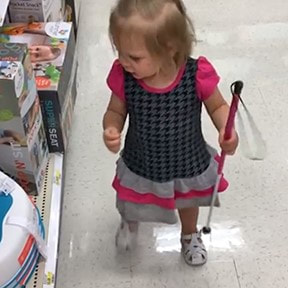How to Travel Without Leaving Your Home
|
|
This activity introduces the concept of Orientation and Mobility through a traveling activity inside your home – without ever packing a suitcase or walking out the front door. Orientation refers to the ability to figure out where you are in space. Mobility refers to the ability to get from one place to the next both safely and efficiently. These are critical skills that your child will begin developing at birth, skills that you can help nurture in their earliest years.
|
Objectives
- Teach child to travel in their familiar environment.
- Increase independence.
- Introduce the concepts of landmarks and cues.
- Encourage child to use all senses to explore and interact with things in the home.
Expanded Core Curriculum Areas Supported
- Orientation and Mobility: Purposeful movement, learn about body parts and self in relation to other objects, learn location and function of objects in the home. Increase tactile exploration with everyday objects such as light switches, doors, and stairs.
- Independent Living: Learn how to get to places where routines take place in the home, such as the kitchen, laundry room, or bathroom.
- Sensory Efficiency: Use senses to explore, understand and interact with things, especially functional vision, touch, and hearing. Use available vision to look at landmarks in the home, such as windows, doors, and pictures on the wall. Hearing verbal cues or using a cane gives auditory and tactile information.
- Social Skills: Bonding and communicating with caregiver during the activity; labeling positive or negative emotions. Learn to play with a partner and communicate by making choices.
- Compensatory Skills: Concept development, touch skills for learning and communication modes, sequencing of steps in travel routine. Increase vocabulary and language and concept development.
- Self-Determination: Choice making, decision making, and problem solving. The activity will answer questions like “Where am I? Where am I going? How will I get there?” The activity will build a child’s confidence in independent movement around the home.
Everyday Routines Supported
This activity supports the “in-betweens” of daily routines – the intentional movement from one activity to the next within a home.
Everyday Routines Supported
This activity supports the “in-betweens” of daily routines – the intentional movement from one activity to the next within a home.
Suggested Next Steps to Use This Activity With Caregiver and Child
- Discuss activity with caregiver to determine appropriateness and relevancy to family.
- Forward the caregiver version of the activity to the caregiver.
- Remind the primary caregiver one to two days before the home/virtual visit to gather the materials required.
- Introduce the activity, discuss the objectives, and provide an overview of the possible steps.
- Be prepared to break down the activities into a smaller subset as the child and family may not have the time or tolerance to complete all activities.
- After completing this activity, consider extension activities that may be appropriate and relevant to the family.

